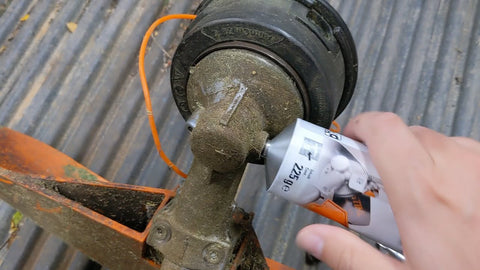Embrace sustainable lawn care with this guide. It is tailored for gardeners who seek to balance meticulous lawn maintenance with ecological responsibility. Let's explore into the world of environmentally-conscious whipper snipper use, uncovering methods and models that significantly lessen your ecological footprint.
We'll guide you through selecting eco-friendlier whipper snippers, employing energy-efficient practices, and maintaining your equipment in a way that supports the health of our planet.
Join us in nurturing your garden while protecting the environment, ensuring your gardening efforts contribute positively to our Earth’s well-being.
Choosing Eco-Friendly Models

Selecting the right whipper snipper model is a crucial step towards eco-friendly gardening. The type of whipper snipper you choose can have a significant impact on the environment, from the energy it consumes to the emissions it produces.
Electric and Battery-Powered Options:
- Lower Emissions: Electric and battery-powered whipper snippers are excellent alternatives to petrol models, as they produce no direct emissions. This reduction in greenhouse gases makes them a more environmentally friendly choice for your garden.
- Advancements in Battery Technology: Modern battery-powered models are equipped with lithium-ion batteries, known for their long life and efficient power usage. These batteries not only offer a cleaner energy source but also provide sufficient power for most residential gardening needs.
Low-Emission Petrol Models:
- Technological Improvements: While petrol models are traditionally not as eco-friendly, advancements in technology have led to the development of low-emission petrol models. These newer models comply with stricter environmental standards, producing fewer pollutants.
- Efficient Fuel Consumption: Look for petrol whipper snippers that are designed to be fuel-efficient, reducing the overall consumption of fossil fuels and minimizing your carbon footprint.
Energy Efficiency:
- Reduced Energy Consumption: Electric models, especially those with energy-efficient motors, consume less power compared to their petrol counterparts. This efficiency translates into lower electricity usage and a smaller carbon footprint.
- Optimal Battery Usage: For battery-powered models, efficient usage and proper charging practices can maximize the battery life and reduce energy waste.
Durability and Longevity:
- Long-Lasting Design: Choosing a whipper snipper that is built to last reduces the need for frequent replacements, thereby decreasing the waste associated with discarded garden tools.
- Quality Over Quantity: Investing in a high-quality model might cost more upfront, but it pays off in the long term with fewer replacements and repairs. This approach not only saves you money but also reduces the environmental impact of manufacturing and disposing of garden equipment.
By opting for electric or battery-powered options and focusing on energy efficiency and durability, you can significantly reduce your environmental impact while maintaining a beautiful garden.
Sustainable Usage Practices
Adopting sustainable practices while using your whipper snipper not only benefits the environment but can also enhance the efficiency and effectiveness of your gardening. Here are key practices to consider for eco-friendly whipper snipper use.
Efficient Operation:
- Optimal Use Times: Use your whipper snipper during times when it's most efficient, such as dry weather conditions, to avoid using excess power on wet or overly dense grass.
- Proper Technique: Employing the right trimming techniques can reduce the time and energy spent. For example, sweeping motions for light trimming and targeted, precise cuts for edging reduce the need for repeated passes.
Proper Cutting Techniques:
- Maintain Blade Sharpness: A sharp blade or line cuts more efficiently, reducing the need for multiple passes and saving energy.
- Adjust Cutting Heights: Adjusting the cutting height appropriately for different areas of your garden can prevent overcutting, which can stress grass and plants, leading to increased water and chemical use for recovery.
Scheduled Maintenance:
- Keeping your whipper snipper well-maintained ensures it operates efficiently. Regularly check and clean air filters, sharpen blades, and ensure batteries are properly charged.
- Eco-friendly Maintenance Products: Use biodegradable lubricants and cleaners for maintenance to minimize chemical runoff into the soil.
Mindful Use of Resources:
- Conserve Electricity: For electric models, be mindful of energy consumption. Use renewable energy sources if available, such as solar panels, to charge your whipper snipper.
- Battery Disposal: Properly dispose of or recycle old batteries from battery-powered models to prevent harmful substances from entering the environment.
Implementing these sustainable usage practices can have a profound impact on reducing the environmental footprint of your whipper snipper use. By focusing on efficiency, proper technique, and eco-friendly maintenance, you can contribute to a healthier ecosystem while keeping your garden immaculately maintained.
Eco-Friendly Maintenance and Care

Maintaining your whipper snipper in an eco-friendly manner is as important as using it sustainably. Proper maintenance not only extends the life of your tool but also ensures it runs efficiently and with minimal environmental impact.
Regular Maintenance for Efficiency:
- Keep it Clean: Regularly clean your whipper snipper to prevent buildup that can hinder performance. A clean tool is more efficient and less likely to require excess power or effort.
- Routine Checks: Frequently check the cutting line or blade for wear, the motor or engine for any issues, and the battery for optimal performance. Addressing small issues promptly can prevent larger, more wasteful problems down the line.
Biodegradable Lubricants and Cleaners:
- Environmentally Friendly Products: Opt for biodegradable lubricants and cleaners when maintaining your whipper snipper. These products are less harmful to the environment and reduce the risk of chemical runoff into your garden.
- Proper Disposal: Ensure you dispose of any old lubricants and cleaners correctly, following local regulations to avoid environmental contamination.
Conserving Water in Cleaning:
- Water-Efficient Cleaning: Use a damp cloth or sponge to clean your whipper snipper rather than hosing it down. This method conserves water and is usually sufficient for routine cleaning.
- Collect and Reuse Water: If you must use water for cleaning, try to collect and reuse it for other purposes in your garden, such as watering plants.
Sustainable Storage Solutions:
- Eco-Friendly Storage: Store your whipper snipper in a way that prolongs its life and reduces the need for resource-intensive replacements. A dry, sheltered location protects it from the elements and reduces wear.
- Recycle and Upcycle: When parts need replacing, look for recycled or upcycled components where possible. This approach minimizes waste and supports circular economy practices.
By incorporating these eco-friendly maintenance and care practices, you not only ensure the longevity and efficiency of your whipper snipper but also contribute positively to environmental sustainability. Every effort, no matter how small, counts towards a healthier planet.
Reducing Noise Pollution
While focusing on the environmental impact of whipper snippers, it's also important to consider the noise pollution they can generate. Reducing noise not only makes for a more pleasant gardening experience but also contributes to a more harmonious community environment.
Quiet Operation Models:
- Low-Noise Options: Seek out whipper snipper models that are designed for quiet operation. Electric and battery-powered models typically produce less noise compared to petrol-powered ones.
- Technological Advancements: Manufacturers are increasingly focusing on reducing the noise level of their equipment. Look for models that highlight noise reduction technologies in their design.
Best Practices for Noise Reduction:
- Mindful Usage Times: Be considerate of your neighbors by using your whipper snipper during reasonable hours. Avoid early mornings, late evenings, and times when noise might be particularly disruptive.
- Maintain Your Equipment: A well-maintained whipper snipper is often quieter. Regularly check and replace any worn parts, such as the cutting line or blade, which can cause excess noise when damaged or dull.
Using Sound Dampening Accessories:
- Ear Protection: While this doesn't reduce the noise emitted, wearing ear protection can safeguard your hearing and make the experience more comfortable for you.
- Adding Mufflers: Some models allow the addition of mufflers or noise-dampening attachments. These can significantly reduce the sound output during operation.
Educating Others on Noise Reduction:
- Sharing Knowledge: Encourage fellow gardeners to adopt noise reduction practices. Educating others about the importance of low-noise gardening contributes to a more peaceful community environment.
- Community Guidelines: If applicable, adhere to local community or homeowner association guidelines regarding noise levels to maintain good relations with your neighbors.
By taking steps to reduce noise pollution while using your whipper snipper, you contribute to a more environmentally respectful and community-friendly gardening practice. This approach not only benefits the natural environment but also fosters a more pleasant and considerate atmosphere in your neighborhood.
Disposal and Recycling
Responsible disposal and recycling of whipper snippers and their components are essential aspects of eco-friendly gardening. Properly handling the end-of-life phase of your garden tools ensures that their environmental impact is minimized.
Responsible Disposal:
- Check Local Regulations: Different areas have specific rules regarding the disposal of power tools and batteries. Familiarize yourself with your local regulations to ensure you're disposing of your whipper snipper responsibly.
- Hazardous Waste Facilities: Petrol-powered whipper snippers and batteries should often be treated as hazardous waste. Locate a nearby facility that can handle these items safely.
Recycling Programs and Options:
- Manufacturer Recycling Programs: Some manufacturers offer take-back or recycling programs for their products. Inquire whether your whipper snipper's manufacturer provides such options.
- Local Recycling Centers: Check with local recycling centers to see if they accept power tools or batteries. These centers ensure that materials are recycled correctly, reducing landfill waste.
Battery Recycling:
- Special Handling: Batteries, particularly lithium-ion, require special handling for recycling. Seek out battery recycling programs or facilities that can process them safely.
- Extending Battery Life: To minimize waste, maximize the lifespan of your whipper snipper's battery by following proper charging and maintenance practices.
Repurposing Parts:
- Upcycling: Consider if any parts of your whipper snipper can be repurposed or upcycled. Creative repurposing can give old tools new life and reduce waste.
- Spare Parts: If your whipper snipper is no longer functional, parts such as the motor, handles, or attachments might be useful for repairs on other tools.
By adopting responsible practices for disposal and recycling, you can significantly reduce the environmental impact of your whipper snipper. This responsible end-of-life management of garden tools is a crucial component of sustainable gardening, contributing to reduced waste and a healthier planet.
Conclusion
Embracing eco-friendly practices in every aspect of whipper snipper use – from selection and operation to maintenance and eventual disposal – is a significant step towards more sustainable gardening. By choosing environmentally conscious models, adopting efficient usage practices, maintaining your tool with eco-friendly products, reducing noise pollution, and responsibly recycling or disposing of your whipper snipper, you contribute to a healthier, more sustainable environment.
We hope this guide has provided you with valuable insights and practical tips for making your whipper snipper usage more eco-friendly. Remember, every step towards sustainability, no matter how small, is a step in the right direction for our planet's health.
Thank you for joining us in this journey towards more sustainable gardening practices. If you're in a look for other gardening tools and workshop equipment, please feel free to visit us here.
May your efforts contribute to a greener, more thriving world.

